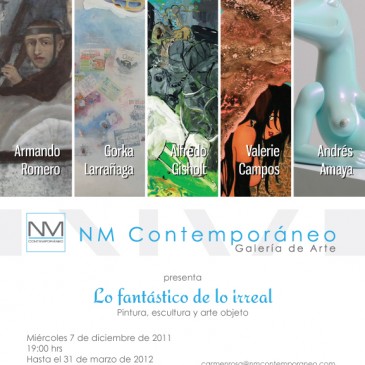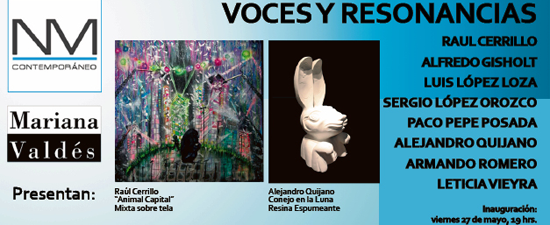Lo fantástico de lo irreal presenta una selección de artistas cuyo factor común son sus referencias cruzadas tanto a la realidad como a la irrealidad haciéndolas convivir en extraños mundos atemporales y lúdicos donde vive Robotina, las Meninas, el Hentai, … Read More
 CUERNO Y BEJUCO Horn and bejuco 18 x 30 x 60 cm |
CUERNOS CON HILO DE ALGODON |
 GUAJE HILADO Bottle gourd and Hemp thread 14 x 14 x 35 cm |
 Terra Viridis 63 Oil on canvas 120 x 200cm |
 Serie S11 Oil on canvas 155 x 225 cm 2013 |
 Terra Viridis 71 Oil on canvas 190 x 250 cm 2011 |
No one can be able (Painted prayers and other chants)
I am absolutely convinced that there is no art without adventure. My adventure keeps finding its way within the regular borders delimiting a painting: in it, things happen, stories unfold, traditional means of time and space are disrupted, messages are encoded, mystery can be glimpsed. As it will be clear with this show, I have a certain inclination for risk. A harmless risk, nonetheless, but meaningful for someone who is just a painter. I step into the quicksands of visual narrative, of the anecdote and the metaphor.
I realized on the fly that through art I could try to fill the void left by disbelief. Others have achieved it. These prayers come from looking back at this internal conflict. The contemplation of these paintings requires to run one’s eyes over them. They are made up of several fragments that may be read in a ascendant or descendant way and each one of them makes sense once this glazing has happened and its content has been interiorized.
The artist’s interaction with his immediate environment regarding urban spaces that make up daily life lends Larrañaga’s work a plural taste of inquisitive originality; for this purpose, Gorka recycles objects and advertising brochures from his city wandering to create pictorial-photographic-sculptural works that constantly verge on abstraction and create open spaces for the viewer.
Mexico City’s valley, with its large dimensions, seems as an exaggeration of any possible form for any other city. That is why its inhabitants call it the monster city: “I’ve had to put up with it, I’ve had to live it, I’ve had to feel it… and sometimes, I’ve hated it, because Mexico City is a city without pedestrians… and I am a pedestrian…”
This look’s approach is placed between the universe of the enthusiasm and the overflowing excitement that the city causes, where One and All dissolve and cancel each other to finally define themselves in the context of what Mexico City means. Uncovering its unfathomable mysteries is one of the purposes of this project.
 CUERNO Y BEJUCO Horn and bejuco 18 x 30 x 60 cm |
CUERNOS CON HILO DE ALGODON |
 GUAJE HILADO Bottle gourd and Hemp thread 14 x 14 x 35 cm |
 Terra Viridis 63 Oil on canvas 120 x 200cm |
 Serie S11 Oil on canvas 155 x 225 cm 2013 |
 Terra Viridis 71 Oil on canvas 190 x 250 cm 2011 |
Eduardo Rincón’s work is based on biological, natural and organic processes that present a reflection on the natural forces that manifest in the form and development of plants. He produces plants experimentally at his workshop and nursery that he later uses for installation purposes, sculpture, drawing and painting. He has taken his research on native trees to reforestation projects.
This artist’s work may be considered as object painting since his work includes objects produced by nature: flowers, seeds and plants that he adds to his pictorial techniques as a real element that opposes to the illusion of image.
Art-Object rises simple, every day objects to the dignity of art as proof that art is, first and foremost, a mental attitude that lives in the mind of the viewer. By exhibiting these paintings/objects, aesthetic qualities may be appreciated instead of their practical purposes. His work makes us accomplices to a flirtation between two and three-dimensional art, technique and expression, and most importantly, between nature and culture.
KODAK ENDURA Metallic VC Paper
Printed at Digital Pro Lab, San Antonio TX
Lab approved by the PPA
Highlighting through contrast. Showing the absurd by means of a parallelism of the opposite reality. Awakening reason through an image that contains a non-symbol. These are some of the question that the Mexican Stanley Shoemaker poses through the digital compositing that he makes on black and white images since five years ago.
According to the photographer, the images intentions, besides the obvious cultural, social and economic contrast, are to make clear that what we see in them may become real, given the homogenizing process at every level that we are living in, but that hasn’t been able to heal the differences between first and third world countries. On the other hand, Shoemaker considers that there are different religions in the world whose promises for human kind are the same: a state of fulfillment, be it in heaven or nirvana,; but they ultimately agree in virtue and distance, which, paradoxically, cause so many conflicts.
 Enciclopedia Akadia Oil on amate paper 170 X 230 cm |
 Misterios del Sinahi Oil on amate paper 176 X 236 cm |
|
 Legado Oil on amate paper 236 X 173 cm |
 Samurai Oil on amate paper 98 X 198 cm |
With the series Adventures in amate Sergio López Orozco tries, with varying resources, return to paper-made objects, qualities or propitiatory votive, not in relation to a preset ritual matter but made ??with poetic tension. The raw material has no expression whatsoever, it is necessary to transfigure it through the invention. In the effort, the soul leaves its mark and obtained relates, unintentionally, with the most remote and unfathomable origins of a tradition as old and established as the use of paper cutouts of bark for healing ceremonies or witchcraft. This custom originated in ancient times and continues to the present, when the paper made ??from amate bark has become popular as a support for paint, coatings and other decorative or artistic uses. The ritual to drive away evils of body and spirit with a large ring of woven paper cut deities is not practiced anywhere. The shaman or shaman must officiate in caves or places consecrated to the case household organized around a central bracero purifying fire.
 Caja de luz policarbonate and acrylic 80 x 94 x 10cm |
 Escultura flotante Irona and policarbonate 50 x 75 x 30 cm |
 Escultura flotante policarbonate and acrylic 50 x 75 x 30 cm |
Paco Pepe Posada’s work ranges from painting, drawing, sculpture and installation sometimes within the same piece. In his work the matter settles at different levels and layers in which signs and a slight trace geometry that accommodates the most diverse media, from resources such as blood, processing and contrast of materials.






















